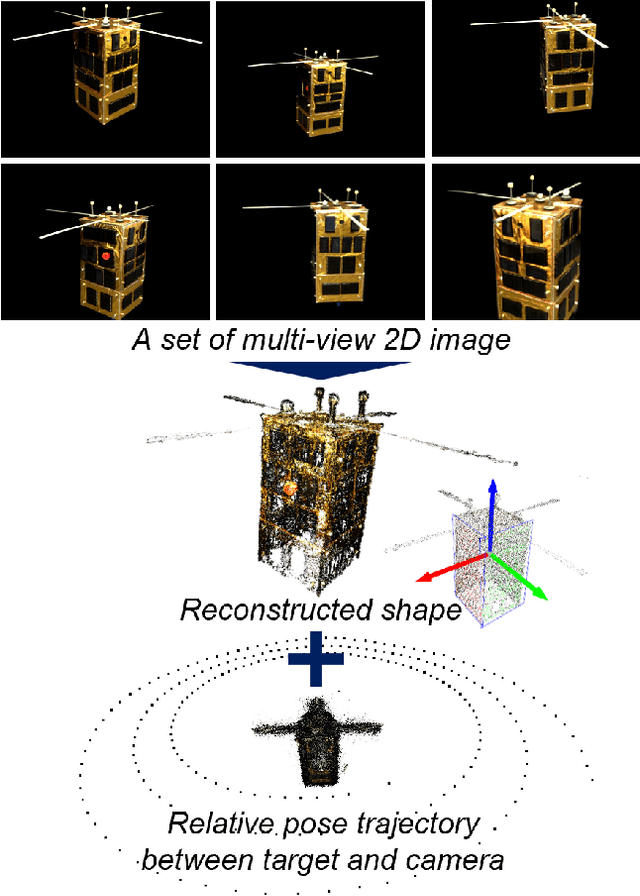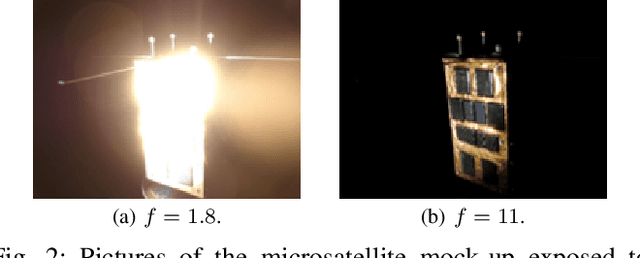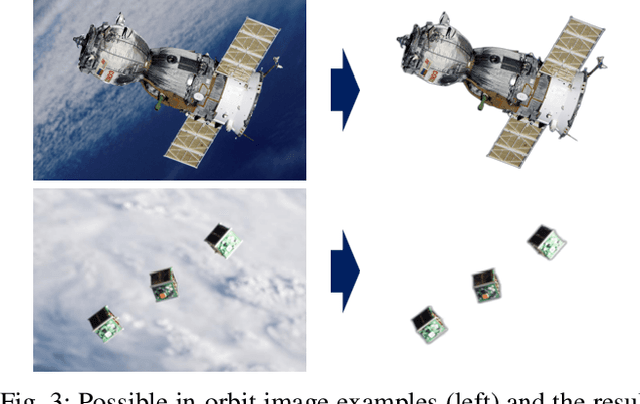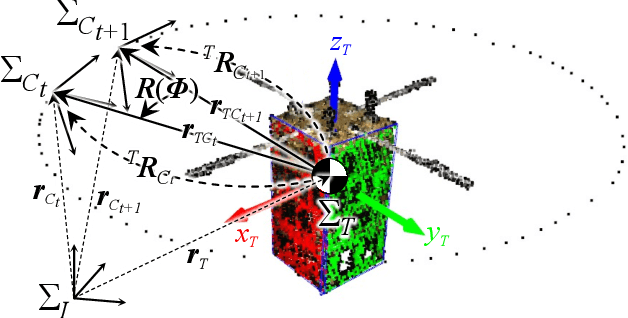Kentaro Uno
Modeling of Terrain Deformation by a Grouser Wheel for Lunar Rover Simulation
Aug 24, 2024Abstract:Simulation of vehicle motion in planetary environments is challenging. This is due to the modeling of complex terrain, optical conditions, and terrain-aware vehicle dynamics. One of the critical issues of typical simulators is that they assume terrain is a rigid body, which limits their ability to render wheel traces and compute the wheel-terrain interactions. This prevents, for example, the use of wheel traces as landmarks for localization, as well as the accurate simulation of motion. In the context of lunar regolith, the surface is not rigid but granular. As such, there are differences in the rover's motion, such as sinkage and slippage, and a clear wheel trace left behind the rover, compared to that on a rigid terrain. This study presents a novel approach to integrating a terramechanics-aware terrain deformation engine to simulate a realistic wheel trace in a digital lunar environment. By leveraging Discrete Element Method simulation results alongside experimental single-wheel test data, we construct a regression model to derive deformation height as a function of contact normal force. The region of interest in a height map is retrieved from the wheel poses. The elevation values of corresponding pixels are subsequently modified using contact normal forces and the regression model. Finally, we apply the determined elevation change to each mesh vertex to render wheel traces during runtime. The deformation engine is integrated into our ongoing development of a lunar simulator based on NVIDIA's Omniverse IsaacSim. We hypothesize that our work will be crucial to testing perception and downstream navigation systems under conditions similar to outdoor or terrestrial fields. A demonstration video is available here: https://www.youtube.com/watch?v=TpzD0h-5hv4
Structure from Motion-based Motion Estimation and 3D Reconstruction of Unknown Shaped Space Debris
Aug 02, 2024



Abstract:With the boost in the number of spacecraft launches in the current decades, the space debris problem is daily becoming significantly crucial. For sustainable space utilization, the continuous removal of space debris is the most severe problem for humanity. To maximize the reliability of the debris capture mission in orbit, accurate motion estimation of the target is essential. Space debris has lost its attitude and orbit control capabilities, and its shape is unknown due to the break. This paper proposes the Structure from Motion-based algorithm to perform unknown shaped space debris motion estimation with limited resources, where only 2D images are required as input. The method then outputs the reconstructed shape of the unknown object and the relative pose trajectory between the target and the camera simultaneously, which are exploited to estimate the target's motion. The method is quantitatively validated with the realistic image dataset generated by the microgravity experiment in a 2D air-floating testbed and 3D kinematic simulation.
Space Debris Reliable Capturing by a Dual-Arm Orbital Robot: Detumbling and Caging
May 02, 2024Abstract:A chaser satellite equipped with robotic arms can capture space debris and manipulate it for use in more advanced missions such as refueling and deorbiting. To facilitate capturing, a caging-based strategy has been proposed to simplify the control system. Caging involves geometrically constraining the motion of the target debris, and is achieved via position control. However, if the target is spinning at a high speed, direct caging may result in unsuccessful constraints or hardware destruction; therefore, the target should be de-tumbled before capture. To address this problem, this study proposes a repeated contact-based method that uses impedance control to mitigate the momentum of the target. In this study, we analyzed the proposed detumbling technique from the perspective of impedance parameters. We investigated their effects through a parametric analysis and demonstrated the successful detumbling and caging sequence of a microsatellite as representative of space debris. The contact forces decreased during the detumbling sequence compared with direct caging. Further, the proposed detumbling and caging sequence was validated through simulations and experiments using a dual-arm air-floating robot in two-dimensional microgravity emulating testbed.
Risk-Aware Coverage Path Planning for Lunar Micro-Rovers Leveraging Global and Local Environmental Data
Apr 29, 2024Abstract:This paper presents a novel 3D myopic coverage path planning algorithm for lunar micro-rovers that can explore unknown environments with limited sensing and computational capabilities. The algorithm expands upon traditional non-graph path planning methods to accommodate the complexities of lunar terrain, utilizing global data with local topographic features into motion cost calculations. The algorithm also integrates localization and mapping to update the rover's pose and map the environment. The resulting environment map's accuracy is evaluated and tested in a 3D simulator. Outdoor field tests were conducted to validate the algorithm's efficacy in sim-to-real scenarios. The results showed that the algorithm could achieve high coverage with low energy consumption and computational cost, while incrementally exploring the terrain and avoiding obstacles. This study contributes to the advancement of path planning methodologies for space exploration, paving the way for efficient, scalable and autonomous exploration of lunar environments by small rovers.
Tightly-Coupled LiDAR-IMU-Wheel Odometry with Online Calibration of a Kinematic Model for Skid-Steering Robots
Apr 03, 2024Abstract:Tunnels and long corridors are challenging environments for mobile robots because a LiDAR point cloud should degenerate in these environments. To tackle point cloud degeneration, this study presents a tightly-coupled LiDAR-IMU-wheel odometry algorithm with an online calibration for skid-steering robots. We propose a full linear wheel odometry factor, which not only serves as a motion constraint but also performs the online calibration of kinematic models for skid-steering robots. Despite the dynamically changing kinematic model (e.g., wheel radii changes caused by tire pressures) and terrain conditions, our method can address the model error via online calibration. Moreover, our method enables an accurate localization in cases of degenerated environments, such as long and straight corridors, by calibration while the LiDAR-IMU fusion sufficiently operates. Furthermore, we estimate the uncertainty (i.e., covariance matrix) of the wheel odometry online for creating a reasonable constraint. The proposed method is validated through three experiments. The first indoor experiment shows that the proposed method is robust in severe degeneracy cases (long corridors) and changes in the wheel radii. The second outdoor experiment demonstrates that our method accurately estimates the sensor trajectory despite being in rough outdoor terrain owing to online uncertainty estimation of wheel odometry. The third experiment shows the proposed online calibration enables robust odometry estimation in changing terrains.
Lower Gravity Demonstratable Testbed for Space Robot Experiments
Sep 19, 2023Abstract:In developing mobile robots for exploration on the planetary surface, it is crucial to evaluate the robot's performance, demonstrating the harsh environment in which the robot will actually be deployed. Repeatable experiments in a controlled testing environment that can reproduce various terrain and gravitational conditions are essential. This paper presents the development of a minimal and space-saving indoor testbed, which can simulate steep slopes, uneven terrain, and lower gravity, employing a three-dimensional target tracking mechanism (active xy and passive z) with a counterweight.
OmniLRS: A Photorealistic Simulator for Lunar Robotics
Sep 16, 2023Abstract:Developing algorithms for extra-terrestrial robotic exploration has always been challenging. Along with the complexity associated with these environments, one of the main issues remains the evaluation of said algorithms. With the regained interest in lunar exploration, there is also a demand for quality simulators that will enable the development of lunar robots. % In this paper, we explain how we built a Lunar simulator based on Isaac Sim, Nvidia's robotic simulator. In this paper, we propose Omniverse Lunar Robotic-Sim (OmniLRS) that is a photorealistic Lunar simulator based on Nvidia's robotic simulator. This simulation provides fast procedural environment generation, multi-robot capabilities, along with synthetic data pipeline for machine-learning applications. It comes with ROS1 and ROS2 bindings to control not only the robots, but also the environments. This work also performs sim-to-real rock instance segmentation to show the effectiveness of our simulator for image-based perception. Trained on our synthetic data, a yolov8 model achieves performance close to a model trained on real-world data, with 5% performance gap. When finetuned with real data, the model achieves 14% higher average precision than the model trained on real-world data, demonstrating our simulator's photorealism.% to realize sim-to-real. The code is fully open-source, accessible here: https://github.com/AntoineRichard/LunarSim, and comes with demonstrations.
Integration of Vision-based Object Detection and Grasping for Articulated Manipulator in Lunar Conditions
Sep 03, 2023Abstract:The integration of vision-based frameworks to achieve lunar robot applications faces numerous challenges such as terrain configuration or extreme lighting conditions. This paper presents a generic task pipeline using object detection, instance segmentation and grasp detection, that can be used for various applications by using the results of these vision-based systems in a different way. We achieve a rock stacking task on a non-flat surface in difficult lighting conditions with a very good success rate of 92%. Eventually, we present an experiment to assemble 3D printed robot components to initiate more complex tasks in the future.
Enabling Faster Locomotion of Planetary Rovers with a Mechanically-Hybrid Suspension
Jul 10, 2023



Abstract:The exploration of the lunar poles and the collection of samples from the martian surface are characterized by shorter time windows demanding increased autonomy and speeds. Autonomous mobile robots must intrinsically cope with a wider range of disturbances. Faster off-road navigation has been explored for terrestrial applications but the combined effects of increased speeds and reduced gravity fields are yet to be fully studied. In this paper, we design and demonstrate a novel fully passive suspension design for wheeled planetary robots, which couples a high-range passive rocker with elastic in-wheel coil-over shock absorbers. The design was initially conceived and verified in a reduced-gravity (1.625 m/s$^2$) simulated environment, where three different passive suspension configurations were evaluated against a set of challenges--climbing steep slopes and surmounting unexpected obstacles like rocks and outcrops--and later prototyped and validated in a series of field tests. The proposed mechanically-hybrid suspension proves to mitigate more effectively the negative effects (high-frequency/high-amplitude vibrations and impact loads) of faster locomotion (>1 m/s) over unstructured terrains under varied gravity fields. This lowers the demand on navigation and control systems, impacting the efficiency of exploration missions in the years to come.
Mobility Strategy of Multi-Limbed Climbing Robots for Asteroid Exploration
Jun 22, 2023Abstract:Mobility on asteroids by multi-limbed climbing robots is expected to achieve our exploration goals in such challenging environments. We propose a mobility strategy to improve the locomotion safety of climbing robots in such harsh environments that picture extremely low gravity and highly uneven terrain. Our method plans the gait by decoupling the base and limbs' movements and adjusting the main body pose to avoid ground collisions. The proposed approach includes a motion planning that reduces the reactions generated by the robot's movement by optimizing the swinging trajectory and distributing the momentum. Lower motion reactions decrease the pulling forces on the grippers, avoiding the slippage and flotation of the robot. Dynamic simulations and experiments demonstrate that the proposed method could improve the robot's mobility on the surface of asteroids.
 Add to Chrome
Add to Chrome Add to Firefox
Add to Firefox Add to Edge
Add to Edge